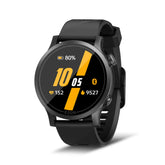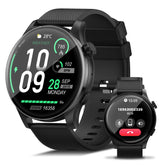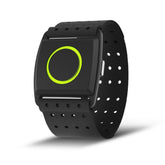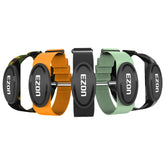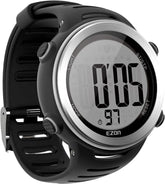Marathon Training for Beginners: A Heartbeat - Monitored Journey to the Finish Line
Training for your first marathon is an incredible challenge, but with a heartbeat monitor as your guide, you’ll pace wisely, recover fully, and cross the finish line strong. This marathon training for beginners plan prioritizes gradual progress, science-backed recovery, and real-time heart rate data to ensure you build endurance without burnout. Let’s turn your marathon dream into a reality, one heartbeat at a time.
1. Why a Heartbeat Monitor is Your Beginner’s Best Friend
A. Avoid Overtraining
- 10% Rule Compliance: Use your monitor to cap weekly mileage increases at 10% (e.g., 20 miles → 22 miles) — a key injury-prevention strategy.
-
Heart Rate Zones:
- Zone 2 (60–70% Max HR): 80% of your runs should be here to build aerobic base (e.g., easy jogs where you can speak in sentences).
- Zone 3 (70–80% Max HR): Save for tempo runs to boost lactate threshold (race-specific stamina).
B. Precision Pacing
- Real-Time Alerts: Set your goal marathon pace (e.g., 6:00/km) and let your monitor vibrate if you start too fast (common beginner mistake!).
- Negative Splits: Train the second half of runs 5–10 seconds faster than the first, using heart rate to ensure you have energy left.
2. 16-Week Training Plan: From Couch to 26.2 Miles
Phase 1: Base Building (Weeks 1–4)
- Goal: Build consistency and adapt to running 4–5 days/week.
- Weekly Mileage: Start with 10–15 miles, focusing on run-walk intervals (e.g., 5 mins run + 1 min walk).
- Heartbeat Monitor Tip: Keep all runs in Zone 2; use the “conversational pace” test (can you talk without gasping? Good pace!).
Phase 2: Endurance Building (Weeks 5–8)
- Goal: Increase long run distance to 10–12 miles.
- Key Workout: One weekly long run at Zone 2, practicing fueling (e.g., gel every 45 minutes).
- Pacing Strategy: Use your monitor’s GPS to maintain a steady pace (e.g., 6:30/km for a 4.5-hour marathon goal).
Phase 3: Intensity & Simulation (Weeks 9–12)
- Goal: Introduce tempo runs and simulate race conditions.
- Tempo Run: 2x15 minutes at Zone 3 (75% Max HR), mimicking marathon race pace.
- Heart Rate Focus: Ensure post-workout heart rate recovers 20 BPM/min — slower recovery means add an extra rest day.
Phase 4: Taper & Race Prep (Weeks 13–16)
- Goal: Reduce fatigue, maintain fitness.
- Mileage Cut: 30% reduction (e.g., 35 miles → 25 miles in Week 13).
- Race Simulation: 18-mile run at goal pace + heart rate check-ins (aim for even effort throughout).
3. Recovery: The Secret to Consistent Training
A. Active Recovery Days
- What to Do: 30-minute walks or yoga at Zone 1 (50–60% Max HR) to flush lactic acid.
- Heart Rate Insight: Use your monitor’s HRV (heart rate variability) — high HRV means your body is ready for intensity.
B. Sleep & Nutrition
- Sleep Tracking: Aim for 7–9 hours/night; your monitor’s sleep staging ensures you get enough deep sleep (critical for muscle repair).
- Post-Run Fuel: 1.5g carbs + 0.3g protein/kg body weight within 60 minutes (e.g., oatmeal + whey protein) to replenish glycogen.
C. Overtraining Signs to Watch For
- Resting heart rate 5+ BPM higher than usual
- Persistent fatigue or mood swings
- Use your heartbeat monitor to log daily RHR and take immediate rest if warned.
4. Pacing Strategies for Race Day
A. Start Conservatively
- First 5K: Run 10% slower than goal pace (e.g., 6:30/km instead of 6:00/km) — your monitor’s pace alert will keep you on track.
- Mid-Race (10–20K): Maintain Zone 3, using heart rate to ensure you’re not overexerting on hills.
B. Finish Strong
- Final 10K: If heart rate is steady, gradually increase pace — your monitor’s real-time data helps avoid the “marathon wall.”
5. Gear Essentials for Beginners
A. Heartbeat Monitor Features to Prioritize
- Chest-Strap or Wrist-Based: Chest straps (e.g., Polar H10) for intense workouts; wrist-based (EZON Heart Rate Series) for daily ease.
- GPS & Route Mapping: Plan routes in advance and track elevation gain to prepare for race-day terrain.
B. Running Shoes
- Neutral or Stability: Get a professional fitting to prevent injuries (replace every 300–500 miles).
- Race-Day Tip: Break in new shoes with 50+ miles of training to avoid blisters.
6. Common Beginner Mistakes to Avoid
- Ignoring Heart Rate Zones: Running too fast on easy days leads to burnout — trust your monitor’s zone alerts.
- Skipping Strength Training: Add 2x/week core + leg workouts (squats, planks) to support running form.
- Neglecting Fueling Practice: Test gels and sports drinks in training to avoid gut issues on race day.
7. Sample Weekly Training Schedule (Weeks 5–8)
| Day | Activity | Heart Rate Focus | Key Metric |
|---|---|---|---|
| Monday | Easy Run | Zone 2 (60–70% MHR) | 30–40 minutes, steady pace |
| Tuesday | Strength Training | N/A | Core + lower body exercises |
| Wednesday | Tempo Run | Zone 3 (70–80% MHR) | 2x10 minutes at goal pace |
| Thursday | Cross-Training | Zone 1–2 | 45 minutes cycling/swimming |
| Friday | Rest or Yoga | N/A | Active recovery, HRV check |
| Saturday | Long Run | Zone 2 | 90 minutes, fueling practice |
| Sunday | Rest or Gentle Walk | N/A | 30 minutes, recovery focus |
Your Marathon Journey Starts with a Single Beat
With a heartbeat monitor as your coach, marathon training for beginners becomes a sustainable, enjoyable process. Focus on heart rate zones to pace wisely, honor recovery to stay injury-free, and let data guide your progress. Remember, every run is a step closer to the finish line — trust the plan, listen to your body, and celebrate each milestone.
Gear up with a reliable monitor, lace up your shoes, and start training with purpose. The marathon is not just a race; it’s a journey of growth, and with the right tools, you’ll cross that line feeling stronger than ever. Ready to take the first step? Your heartbeat is the rhythm — let it lead the way.
EZON Watch: Professional sports technology brand
https://ezonwatch.com
https://ezonwatch.com
